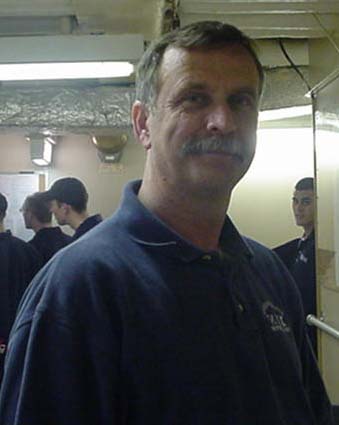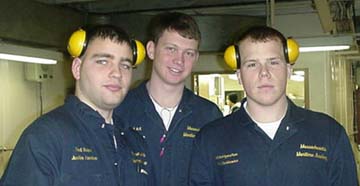
| January 2002 | ||||||
| Sun | Mon | Tue | Wed | Thu | Fri | Sat |
| 1 | 2 | 3 | 4 | 5 | ||
| 6 | 7 | 8 | 9 | 10 | 11 | 12 |
| 13 | 14 | 15 | 16 | 17 | 18 | 19 |
| 20 | 21 | 22 | 23 | 24 | 25 | 26 |
| 27 | 28 | 29 | 30 | 31 | ||
Tuesday 22 January 2002
At 1200, EST the Training Ship Empire State was located 177 nautical miles west of the Dry Tortugas, at 24 degrees and 32 minutes North Latitude and 086 degrees 08 minutes West Longitude, steering course 265 degrees true at a speed of 11 knots. The weather was good; partly cloudy, wind from the east at 10 knots, air temperature was 78 degrees Fahrenheit, barometric pressure was 1023 millibars, seas were from the east at 1 to 3 feet, sea injection temperature was 78 degrees Fahrenheit. Depth of water beneath the keel was 1842 fathoms.
CAPTAIN'S LOG
"Use your gifts faithfully, and they shall be enlarged; practice what you know, and you shall attain to higher knowledge."
SIR EDWIN ARNOLD (1832-1904) Poet and journalist
Lifeboat qualifications completed without a hitch early yesterday afternoon, and we quickly left the moor to begin the long, southwestwardly transit to Vera Cruz, Mexico. The events of the past three days have proven more productive than I might have hoped. We plan for and expect success when it comes to ship's operations but accurately predicting cadet response to stimuli is often more problematic. However, the combination of elation at the Patriots' victory, relaxation with Sunday at Sea, and relief and a sense of accomplishment on completion of lifeboat qualifications, has propelled morale to a new high. The Cadets are finally more comfortable with their surroundings and most have settled nicely into the demanding at sea routine. The majority of the mess deck scuttlebutt (gossip) now centers on the future rather than on the past; Vera Cruz is heard more than Buzzards Bay and the stormy rough ride has become a legitimate Sea Term, sea story.
As we steam onward in the Gulf of Mexico, far from the sight of land, one finds it easy to forget that this vast expanse of seawater is actually a giant watershed, yes a watershed. Our Marine Safety students, very concerned about water pollution and the sources thereof will quickly point this out and our Maritime Business crowd is quick to calculate the monetary losses associated with pollution. Many of us have intimate knowledge of the "woodshed" but even though everyone lives in one, most have no idea about a watershed. Let me tell you. (I learned only yesterday). The Gulf of Mexico's watershed is actually a very large ecological community (2 million square miles) that includes 31 of our 50 states and all the birds, beasts, fish, and people residing therein. These many, many square miles of dirt (includes lawns, and city streets as well as farmlands and forests) are drained by the interconnecting rivers, lakes, and streams that flow or seep over, under, around, and through this giant sandbox.
Those folks living in the five states bordering the Gulf have no problem understanding this concept. Whatever it is that they (or their pets) dump onto the ground quickly reaches the Gulf. They go to the beach, or maybe not if fecal coliform counts are found too high. But what about all those folks who live well upstream, somewhere between the Rocky Mountains and the Appalachians? States from Montana to Maryland send run-off to the Gulf via some thirty-three major rivers and hundreds of small streams. Maybe that Styrofoam cup that I see bobbing off to port, floated in from downtown Dubuque or midtown Scranton.
The Gulf of Mexico is vast. It covers more than 617,000 square miles but despite the sheer volume of water that it contains, pollutants coming from the watershed are taking a toll. Shellfisheries are threatened, estuaries are dying, and the combination of natural processes and human induced pollution are damaging ever-increasing areas of this treasure. So, as the MSEP students tell me; do your part; be ever vigilant. The 168 gallons of water that you will use today may seem insignificant when compared to the 500,000 cubic feet of water (7.480 gallons per cubic foot) that the Mississippi River dumps into the Gulf every second, but it is part and every ounce counts.
See you tomorrow from cleaner waters... farther south.
CADET'S COMMENT
Back to Work By 1/C Katelyn Ladden
Sunday was a cadet's dream. The ship and most of the crew seemed to take a very big sigh of relief. The day began with an assortment of activities and ended with fun. Many lounged in the tropical sun atop number one hatch while others jousted in the shade of two hold. Buckets of cool seawater were drawn from the inviting ocean and the sun worshipers were liberally doused to provide a little relief from the scorching sun.
The 3 on 3 basketball games were hotly contested for most of the day. From the stern, one could hear the sharp report of shotguns as sharp shooting cadets turned hundreds of clay pigeons into dust. Chartwells Dining Services kept the bar-b-que fires burning throughout the day cooking hamburgers, hotdogs, steaks, and chickens to order. Much to the delight of the cadets, ice cream was served after dinner. As sunset came and cool sea breezes replaced the heat of day, everyone was thankful for the fun and relaxation made possible by Sunday at Sea.
Going back to work yesterday was difficult especially after the lazy way that we spent Sunday. The weather was hazy, hot, and humid and jumping over the side into the cool refreshing ocean was on the minds of most who were busily working around the ship. A few off-watch crewmembers and cadets were fishing from the stern while we were anchored for 3rd class cadets to complete lifeboat qualifications. They perfect lifeboat skills by lowering the boats from high upon the embarkation deck, maneuvering them around the ship, and safely recovering them. Under the watchful eye of Captain Dalton, lifeboat number 3 was lowered into the sea. The falls were released and the lifeboat motored away from the Empire State. It appeared that those in the lifeboat did not want to return as the boat moved farther and farther away. Suddenly, the coxswain seemed to come back to reality as she turned the boat into a long, graceful arch to starboard and reluctantly steered the little boat along side. When the boat had been hoisted into the waiting cradle, Captain Dalton yelled "next", another cadet stepped forward, took command, and the process was repeated.

Watching the lifeboats as they were hauled onto the embarkation deck gave me a strong appreciation for the reasons that we practice so much. The little boats swing from side to side when the sea is as calm as glass. Imagine how they would rock if the ship was in a storm and they were needed. Well, let's hope that the good weather continues for a few more days because in only four more days we will arrive in Vera Cruz, Mexico!
Break Time
When anchored yesterday, while the 3/C engineers and marine transportation cadets completed their lifeboat training, some of the 1/C engineers completed one of their mandatory assessments. Both the marine transportation and the marine engineering cadets must complete a number of practical assessments on cruise. Yesterday, 1/C engineers manned the after steering gear room to simulate the loss of steering from the bridge. Throughout the sea term, engineers practice for this eventuality but they never switch control to after steering or maneuver the vessel. (the deckies like to have control) But yesterday, since the ship was sitting at anchor, the engineers actually shifted the rudder with the secondary control system located in the steering gear room, instead of simply going through the motions. They knew that it would work.

The weather grows hotter as we proceed farther south and so, the time between rest breaks is shortened. The mess deck is open for most of the day except for an hour after each meal, and cadets seem to have alarms set to alert them as to when they can return. The scullery crew no sooner finishes cleaning after one group than another bunch of hungry, dry cadets charge down the ladder wells and attack everything edible in sight.
After chipping paint in the hot sun with protective gear on, working in the engine room where temperatures can exceed 100 degrees, or studying in the hot classrooms where it is difficult to stay awake and pay attention, a nice refreshing drink and something to eat is always welcome. Others choose to spend the break catching a few extra rays or napping. However, everyone would agree there is nothing like a break and all look forward to the next one.
QUESTIONS FOR WEDNESDAY 23 JANUARY
MATH: Six cadets played in the 3 on 3 basketball tournament. They scored 13 points, 15 points, 20 points, 22 points, 18 points, and 10 points respectively. What is the mean of their scores?
SCIENCE: The words "isotherm" and "isobar" are terms that are used in weather charts. What does the prefix "iso" mean? What do the root words "therm" and bar mean?
GEOGRAPHY: Florida leads all other states in the nation in the production of this type of crop. In fact, Florida supplies two thirds of the total production of this crop in the U. S. Five fruits make up this type of crop. What is the general name for this crop? Can you name the five (5) fruits that are included?
HISTORY: Spain was very interested in exploring Florida in the early 1500's. One of these brave explorers landed a group at Tampa Bay and traveled from Florida into the North American continent discovered the Mississippi River (1541) and went even further into what is now part of the southwestern part of the United States. This explorer died and his body was sunk in the Mississippi. Of the 600 who began the exploration only about 300 returned. What was the name of the leader?
ANSWERS FOR TUESDAY 21 JANUARY
MATH: 18/25 = 18 divided by 25 = .72 or 72%
SCIENCE: Lightning is a sudden discharge or spark, of electricity between two clouds or between a cloud and the ground.
GEOGRAPHY: Humid subtropical (most of the state): Tropical (the southern tip)
HISTORY: The Indian tribe was the Seminole Tribe. The Indian leader was Osceola (Black Drink Singer).